自主学习Flappy Bird游戏
背景



强化学习

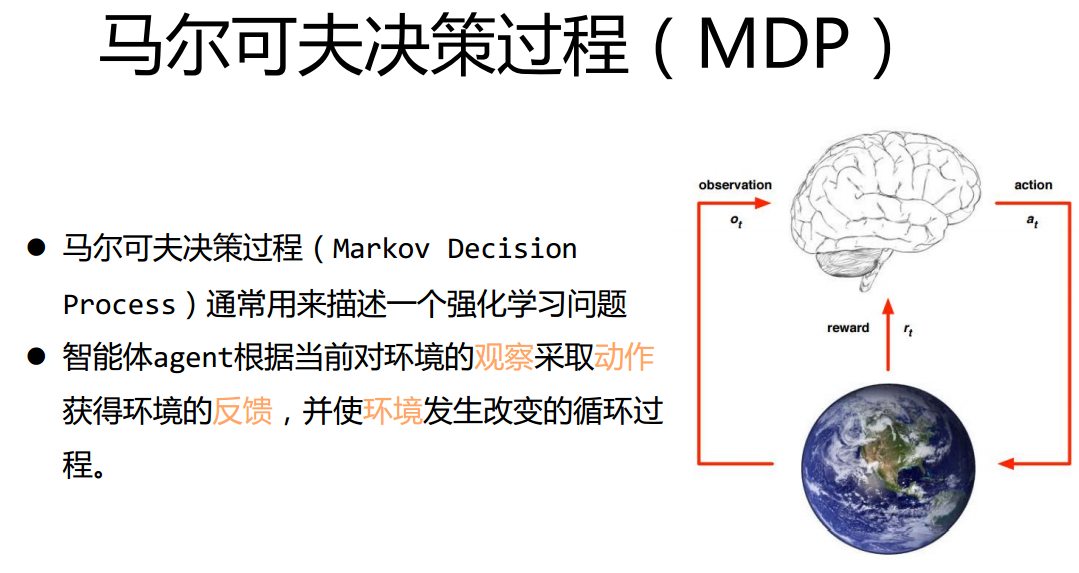
- MDP基本元素
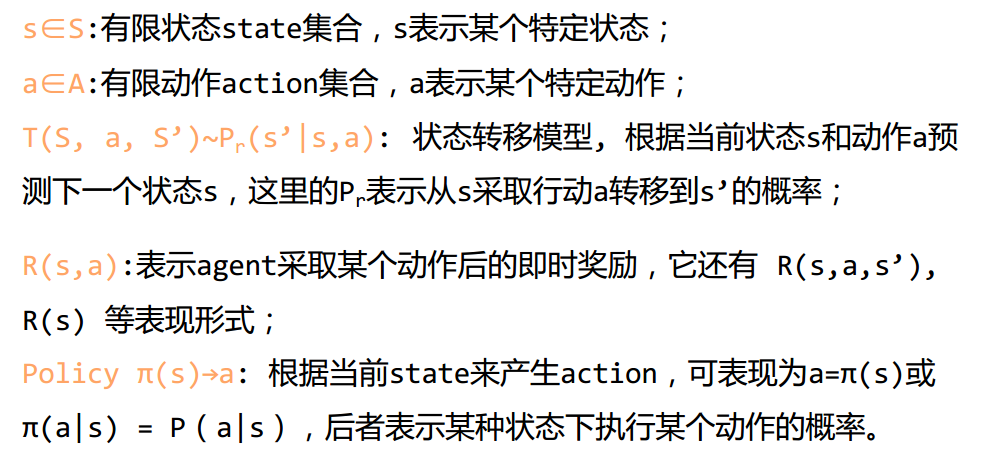


- 这部分比较难懂,没有详细看:最优函数值,最优控制等
Q-learning


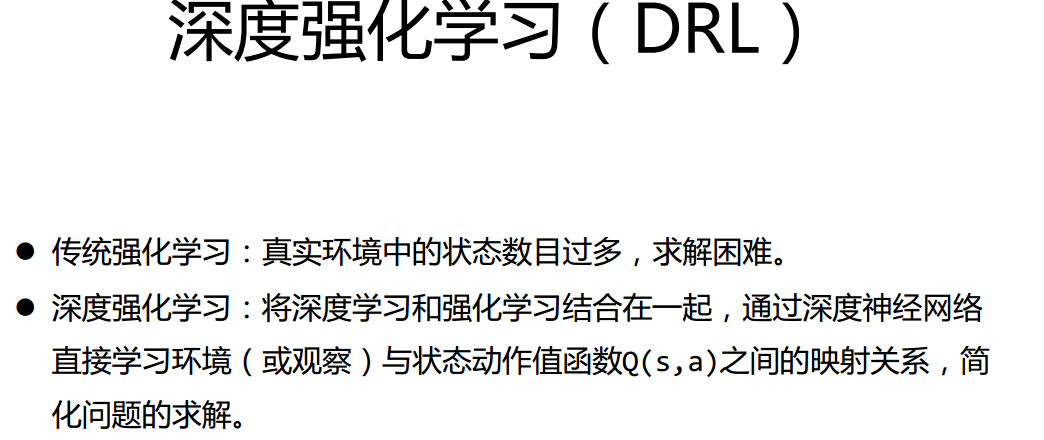


神经网络

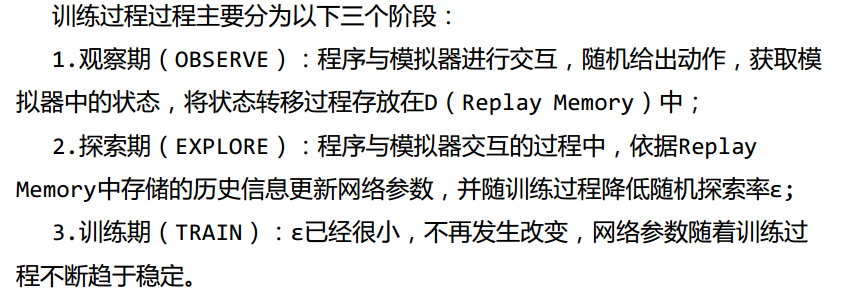
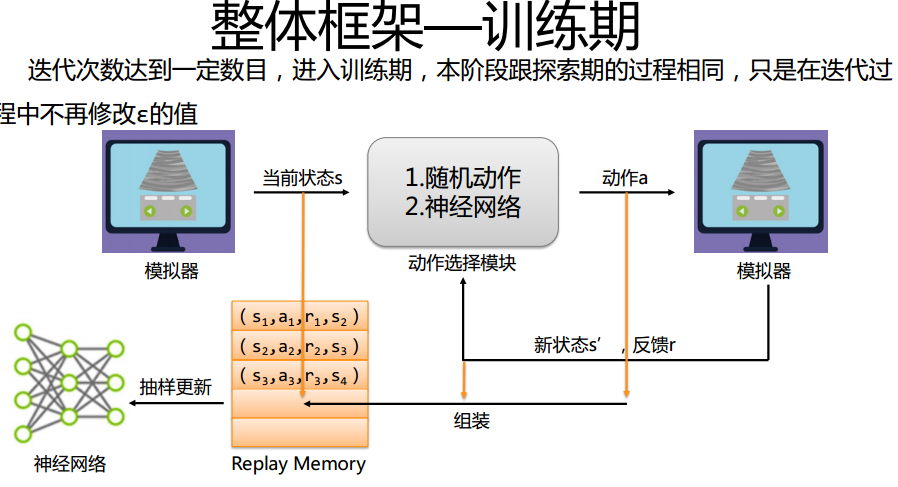
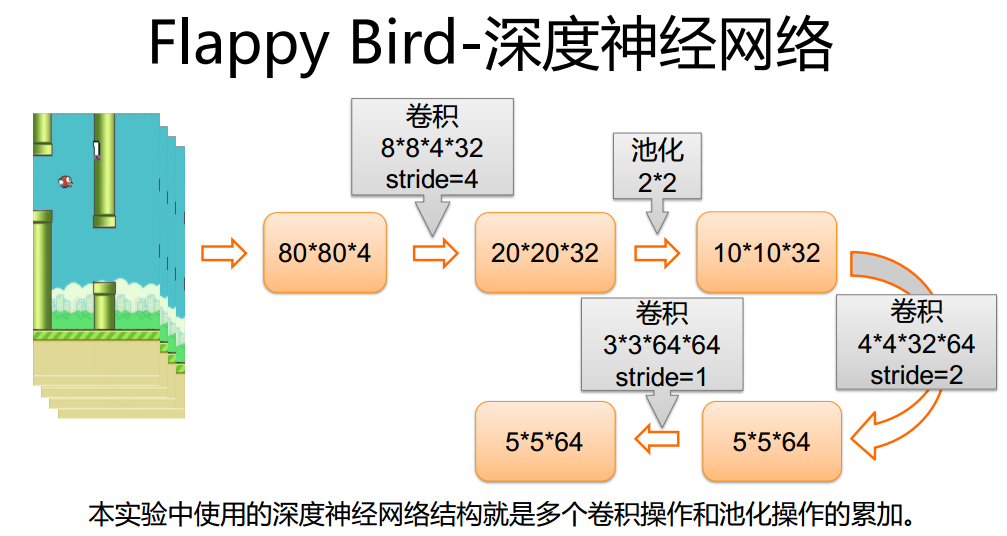
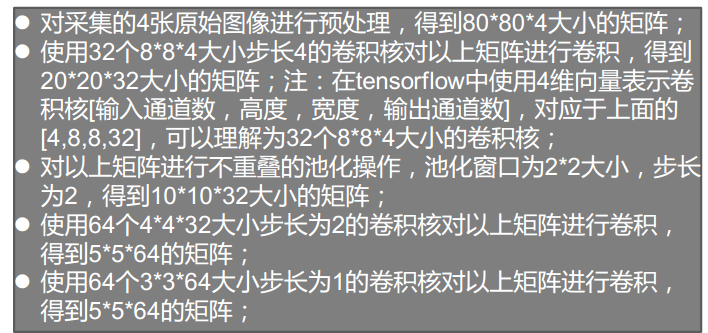

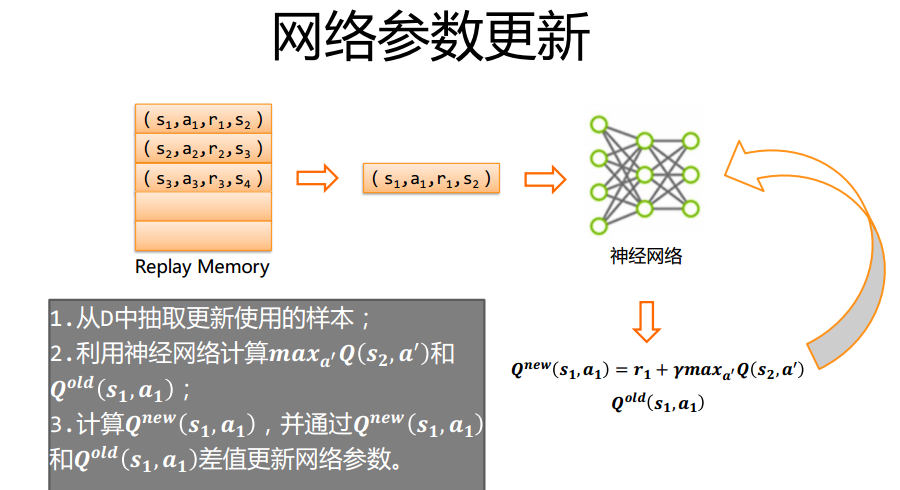
环境搭建
- windows下通过pip安装TensorFlow,opencv-python,pygame
实验
#!/usr/bin/env python
from __future__ import print_function import tensorflow as tf
import cv2
import sys
sys.path.append("game/")
import wrapped_flappy_bird as game
import random
import numpy as np
from collections import deque GAME = 'bird' # the name of the game being played for log files
ACTIONS = 2 # number of valid actions
GAMMA = 0.99 # decay rate of past observations
OBSERVE = 100000. # timesteps to observe before training
EXPLORE = 2000000. # frames over which to anneal epsilon
FINAL_EPSILON = 0.0001 # final value of epsilon
INITIAL_EPSILON = 0.0001 # starting value of epsilon
REPLAY_MEMORY = 50000 # number of previous transitions to remember
BATCH = 32 # size of minibatch
FRAME_PER_ACTION = 1 def weight_variable(shape):
initial = tf.truncated_normal(shape, stddev = 0.01)
return tf.Variable(initial) def bias_variable(shape):
initial = tf.constant(0.01, shape = shape)
return tf.Variable(initial) def conv2d(x, W, stride):
return tf.nn.conv2d(x, W, strides = [1, stride, stride, 1], padding = "SAME") def max_pool_2x2(x):
return tf.nn.max_pool(x, ksize = [1, 2, 2, 1], strides = [1, 2, 2, 1], padding = "SAME") def createNetwork():
# network weights
W_conv1 = weight_variable([8, 8, 4, 32])
b_conv1 = bias_variable([32]) W_conv2 = weight_variable([4, 4, 32, 64])
b_conv2 = bias_variable([64]) W_conv3 = weight_variable([3, 3, 64, 64])
b_conv3 = bias_variable([64]) W_fc1 = weight_variable([1600, 512])
b_fc1 = bias_variable([512]) W_fc2 = weight_variable([512, ACTIONS])
b_fc2 = bias_variable([ACTIONS]) # input layer
s = tf.placeholder("float", [None, 80, 80, 4]) # hidden layers
h_conv1 = tf.nn.relu(conv2d(s, W_conv1, 4) + b_conv1)
h_pool1 = max_pool_2x2(h_conv1) h_conv2 = tf.nn.relu(conv2d(h_pool1, W_conv2, 2) + b_conv2)
#h_pool2 = max_pool_2x2(h_conv2) h_conv3 = tf.nn.relu(conv2d(h_conv2, W_conv3, 1) + b_conv3)
#h_pool3 = max_pool_2x2(h_conv3) #h_pool3_flat = tf.reshape(h_pool3, [-1, 256])
h_conv3_flat = tf.reshape(h_conv3, [-1, 1600]) h_fc1 = tf.nn.relu(tf.matmul(h_conv3_flat, W_fc1) + b_fc1) # readout layer
readout = tf.matmul(h_fc1, W_fc2) + b_fc2 return s, readout, h_fc1 def trainNetwork(s, readout, h_fc1, sess):
# define the cost function
a = tf.placeholder("float", [None, ACTIONS])
y = tf.placeholder("float", [None])
readout_action = tf.reduce_sum(tf.multiply(readout, a), reduction_indices=1)
cost = tf.reduce_mean(tf.square(y - readout_action))
train_step = tf.train.AdamOptimizer(1e-6).minimize(cost) # open up a game state to communicate with emulator
game_state = game.GameState() # store the previous observations in replay memory
D = deque() # printing
a_file = open("logs_" + GAME + "/readout.txt", 'w')
h_file = open("logs_" + GAME + "/hidden.txt", 'w') # get the first state by doing nothing and preprocess the image to 80x80x4
do_nothing = np.zeros(ACTIONS)
do_nothing[0] = 1
x_t, r_0, terminal = game_state.frame_step(do_nothing)
x_t = cv2.cvtColor(cv2.resize(x_t, (80, 80)), cv2.COLOR_BGR2GRAY)
ret, x_t = cv2.threshold(x_t,1,255,cv2.THRESH_BINARY)
s_t = np.stack((x_t, x_t, x_t, x_t), axis=2) # saving and loading networks
saver = tf.train.Saver()
sess.run(tf.initialize_all_variables())
checkpoint = tf.train.get_checkpoint_state("saved_networks")
if checkpoint and checkpoint.model_checkpoint_path:
saver.restore(sess, checkpoint.model_checkpoint_path)
print("Successfully loaded:", checkpoint.model_checkpoint_path)
else:
print("Could not find old network weights") # start training
epsilon = INITIAL_EPSILON
t = 0
while "flappy bird" != "angry bird":
# choose an action epsilon greedily
readout_t = readout.eval(feed_dict={s : [s_t]})[0]
a_t = np.zeros([ACTIONS])
action_index = 0
if t % FRAME_PER_ACTION == 0:
if random.random() <= epsilon:
print("----------Random Action----------")
action_index = random.randrange(ACTIONS)
a_t[random.randrange(ACTIONS)] = 1
else:
action_index = np.argmax(readout_t)
a_t[action_index] = 1
else:
a_t[0] = 1 # do nothing # scale down epsilon
if epsilon > FINAL_EPSILON and t > OBSERVE:
epsilon -= (INITIAL_EPSILON - FINAL_EPSILON) / EXPLORE # run the selected action and observe next state and reward
x_t1_colored, r_t, terminal = game_state.frame_step(a_t)
x_t1 = cv2.cvtColor(cv2.resize(x_t1_colored, (80, 80)), cv2.COLOR_BGR2GRAY)
ret, x_t1 = cv2.threshold(x_t1, 1, 255, cv2.THRESH_BINARY)
x_t1 = np.reshape(x_t1, (80, 80, 1))
#s_t1 = np.append(x_t1, s_t[:,:,1:], axis = 2)
s_t1 = np.append(x_t1, s_t[:, :, :3], axis=2) # store the transition in D
D.append((s_t, a_t, r_t, s_t1, terminal))
if len(D) > REPLAY_MEMORY:
D.popleft() # only train if done observing
if t > OBSERVE:
# sample a minibatch to train on
minibatch = random.sample(D, BATCH) # get the batch variables
s_j_batch = [d[0] for d in minibatch]
a_batch = [d[1] for d in minibatch]
r_batch = [d[2] for d in minibatch]
s_j1_batch = [d[3] for d in minibatch] y_batch = []
readout_j1_batch = readout.eval(feed_dict = {s : s_j1_batch})
for i in range(0, len(minibatch)):
terminal = minibatch[i][4]
# if terminal, only equals reward
if terminal:
y_batch.append(r_batch[i])
else:
y_batch.append(r_batch[i] + GAMMA * np.max(readout_j1_batch[i])) # perform gradient step
train_step.run(feed_dict = {
y : y_batch,
a : a_batch,
s : s_j_batch}
) # update the old values
s_t = s_t1
t += 1 # save progress every 10000 iterations
if t % 10000 == 0:
saver.save(sess, 'saved_networks/' + GAME + '-dqn', global_step = t) # print info
state = ""
if t <= OBSERVE:
state = "observe"
elif t > OBSERVE and t <= OBSERVE + EXPLORE:
state = "explore"
else:
state = "train" print("TIMESTEP", t, "/ STATE", state, \
"/ EPSILON", epsilon, "/ ACTION", action_index, "/ REWARD", r_t, \
"/ Q_MAX %e" % np.max(readout_t))
# write info to files
'''
if t % 10000 <= 100:
a_file.write(",".join([str(x) for x in readout_t]) + '\n')
h_file.write(",".join([str(x) for x in h_fc1.eval(feed_dict={s:[s_t]})[0]]) + '\n')
cv2.imwrite("logs_tetris/frame" + str(t) + ".png", x_t1)
''' def playGame():
sess = tf.InteractiveSession()
s, readout, h_fc1 = createNetwork()
trainNetwork(s, readout, h_fc1, sess) def main():
playGame() if __name__ == "__main__":
main()
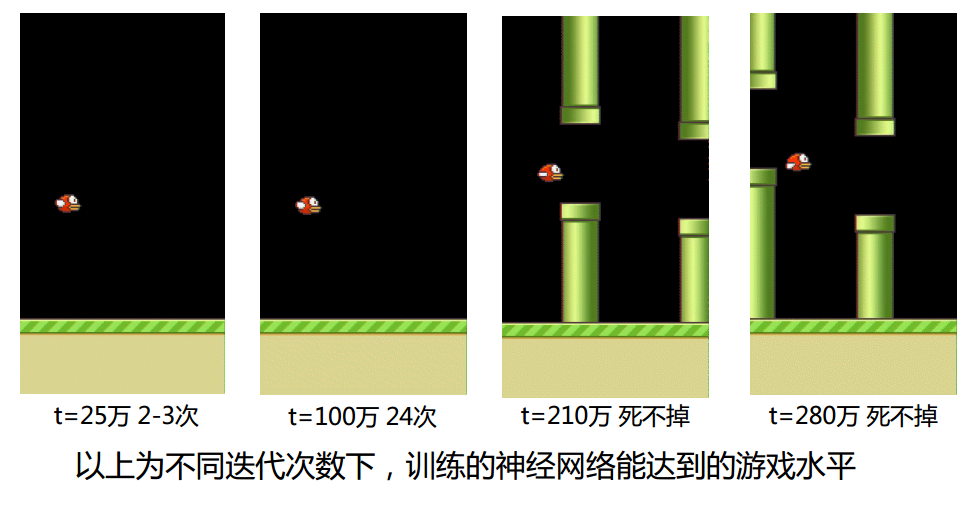
- https://github.com/yenchenlin/DeepLearningFlappyBird
自主学习Flappy Bird游戏的更多相关文章
- 65行 JavaScript 代码实现 Flappy Bird 游戏
飞扬的小鸟(Flappy Bird)无疑是2014年全世界最受关注的一款游戏.这款游戏是一位来自越南河内的独立游戏开发者阮哈东开发,形式简易但难度极高的休闲游戏,很容易让人上瘾. 这里给大家分享一篇这 ...
- 飞翔的圆(Flappy Bird)游戏源码
这个源码是一个不错的休闲类的游戏源码,飞翔的圆(Flappy Bird)游戏源码V1.0,本项目是一个仿Flappy Bird的小游戏,只不过是把Flappy Bird里面的鸟替换成了简单的圆.感兴趣 ...
- 在code.org上自己写一个flappy bird游戏
博客搬到了fresky.github.io - Dawei XU,请各位看官挪步.最新的一篇是:在code.org上自己写一个flappy bird游戏.
- cocos2dx-html5 实现网页版flappy bird游戏
我也是第一次使用cocos2d_html5,对js和html5也不熟,看引擎自带的例子和引擎源码,边学边做,如果使用过cocos2d-x的话,完成这个游戏还是十分简单的.游戏体验地址: http:// ...
- flappy bird游戏源代码揭秘和下载
转:http://blog.csdn.net/touchsnow/article/details/19071961 背景: 最近火爆全球的游戏flappy bird让笔者叹为观止,于是花了一天的时间山 ...
- 利用python开发的flappy bird 游戏
python 中 pygame模块能让我们很方便的编写游戏,16年我用python 仿制了flappy bird 游戏,下面是游戏的完整代码以及素材,分享给大家. 第一个python文件,flappy ...
- Python3+pygame实现的flappy bird游戏,代码完整,还有音乐
之前一直在手机上玩flappy bird游戏,闲暇时间就编写了一个 是采用python3+pygame模块制作而成的,运行效果非常流畅,会让你大吃一惊哦哈哈 一.运行效果展示 下载游戏之后,注意在自己 ...
- 用Phaser实现Flappy Bird 游戏
How to Make a Flappy Bird in HTML5 With Phaser - Part 1 Flappy Bird is a nice little game with easy ...
- 自己动手写游戏:Flappy Bird
START:最近闲来无事,看了看一下<C#开发Flappy Bird游戏>的教程,自己也试着做了一下,实现了一个超级简单版(十分简陋)的Flappy Bird,使用的语言是C#,技术采用了 ...
随机推荐
- syslog命令
更多请关注 Linux命令大全 syslog 介绍 syslog是Linux系统默认的日志守护进程.默认的syslog配置文件是/etc/syslog.conf文件.程序,守护进程和内核提供了访问系统 ...
- java的synchronized可重入锁
在java内部,同一线程在调用自己类中其他synchronized方法/块或调用父类的synchronized方法/块都不会阻碍该线程的执行,就是说同一线程对同一个对象锁是可重入的,而且同一个线程可以 ...
- luogu1129 [ZJOI2007]矩阵游戏
其实,只用考虑某一行能否放到某一行就行了 #include <iostream> #include <cstring> #include <cstdio> usin ...
- WordPress 编辑器没有可视化
第一次安装wordpress后出现文章编辑器只有一行按钮的问题,即使我安装了其他的编辑插件也是一样只有一行, 解决方法: 原来是再Users->All Users 中勾选了Disable the ...
- TOJ 4804: 树网的核
这个是NOIP的提高组的题 4804: 树网的核 Time Limit(Common/Java):1000MS/3000MS Memory Limit:65536KByteTotal Sub ...
- POJ 1543 Perfect Cubes
Perfect Cubes Time Limit: 1000MS Memory Limit: 10000K Total Submissions: 12595 Accepted: 6707 De ...
- spring配置druid连接池和监控数据库访问性能
Druid连接池及监控在spring配置如下: <bean id="dataSource" class="com.alibaba.druid.pool.DruidD ...
- ios sqlite 简单使用
// // ViewController.m // sqlitedemo // // Created by lam_TT on 15-4-11. // Copyright (c) 2015年 lam_ ...
- 写给新员工的十点SQL开发建议
1.建立自己的知识体系 摘抄一句话你所拥有的知识并不取决于你记得多少,而在于它们能否在恰当的时候被回忆起来: 做笔记: 把笔记放在可以随时被找到的地方.个人的笔记可以放在印象笔记之类工具上,单位上的笔 ...
- servlet分析
Servlet生命周期分为三个阶段: 1,初始化阶段 调用init()方法 2,响应客户请求阶段 调用service()方法 3,终止阶段 调用destroy()方法 Servlet初始化阶段: 在 ...
